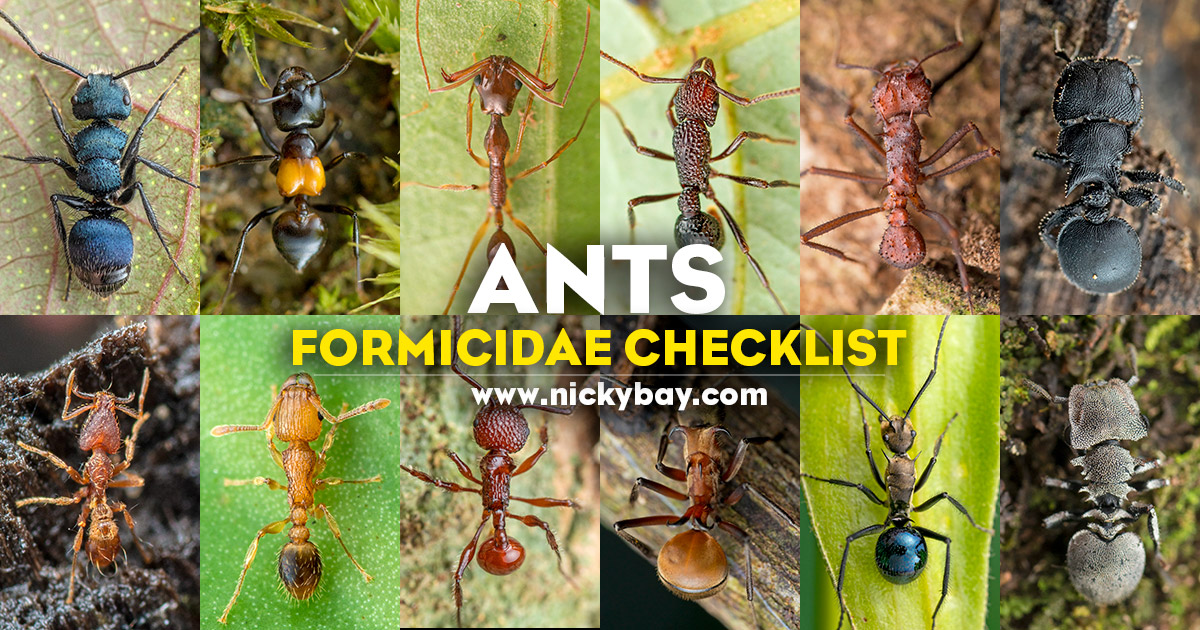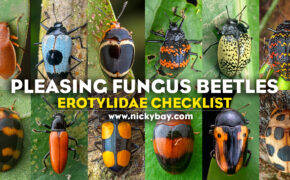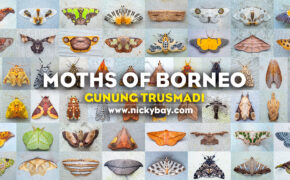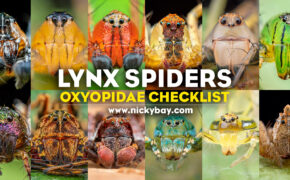Formicidae Checklist: Ants
Ants are fascinating, eusocial insects belonging to the family Formicidae and have captured the imagination of humans for centuries. With over 12,000 species known to science, these tiny insects have been recorded on every continent on Earth except Antarctica. Ants thrive so well in most environments that they may form up to 25% of terrestrial animal biomass[1].
Ant Behaviour
Ants are highly social insects that live in colonies or communities. These colonies can range in size from just a few individuals to millions of ants, depending on the species. Ants are known for their incredible work ethic and their ability to work together to achieve a common goal. They are highly organised and communicate with each other using a complex system of pheromones to find food, navigate, and communicate with each other.
Social Structure of Ants
Ants have a complex social structure that is based on a hierarchy. At the top of the hierarchy is the queen ant, who is the mother of all the other ants in the colony. The queen ant is responsible for laying eggs and ensuring the survival of the colony. The worker ants are responsible for caring for the young, foraging for food, and defending the colony.
Nuptial Flight
The nuptial flight of ants is a reproductive strategy that is observed in many ant species. The winged male and female ants from different colonies leave their nests and take to the air to mate when certain environmental factors such as temperature, humidity, and the availability of food are met. Mating with individuals from other colonies ensures genetic diversity and avoids genetic issues that come with inbreeding. In general, nuptial flights tend to occur after the rain as there would be sufficient moisture for the queen to establish a new colony. During the nuptial flight, the queen ant will release pheromones to signal to the male ants that it is time to take to the air. The males will then swarm around the queen and attempt to mate with her. By natural selection, the strongest males would get to mate with the queen to pass on the strongest genes.
The male ants will die soon after mating, while the female ants will lose its wings and attempt to find a suitable place to establish a new colony. This is a critical time for the female ants, as they must find a location that provides safety and sufficient resources for them to start a new colony.

A female dealate showing a larger thorax and wing scars
In ants, “alate” refers to the winged individuals. Conversely, “dealate” refers to those that have shed its wings. Dealate individuals can be recognised by its wing scars. Females tend to have a larger thorax as it requires more muscles for the wings to fly further in search of a suitable spot for its new colony.
Ecological Importance of Ants
Ants are an important part of many ecosystems and play a crucial role in maintaining the balance of nature. They are important predators, controlling the populations of other insects, and they also help to disperse seeds and aerate the soil. Ants are also important decomposers, breaking down organic matter and recycling nutrients.
In agriculture, ants are important pollinators and natural pest controllers. They can be used as a natural alternative to pesticides, reducing the need for harmful chemicals in farming.[2]
Ants as Pets
Ants can make fascinating and low-maintenance pets for people who are interested in observing the behaviour and social structure of these fascinating insects up close. However, it is important to obtain them legally and ethically, provide them with suitable habitats and food, and research their behaviour to ensure their safety and well-being. With the proper care and attention, ants can make wonderful and low-maintenance pets for those interested in the fascinating world of these incredible insects.
Identification
Ants have distinctively elbowed antennae and slender waists formed by nodular structures.
Most identifications here were made with reference to keys and photographs on AntWiki, as well as help from kind folks from the Myrmecologists Facebook group.
All photos are of live subjects shot in the field. Click on individual photos for larger views and views from other angles. As specimens were not collected, identifications were done based purely on photographs and may not be 100% accurate.
This page will be updated regularly, please let me know if you spot any mistakes.
View my complete Flickr photo set: Formicidae – Ants.
Region Filters
Click on any region to show only records from that region.
Class: Insecta Linnaeus, 1758
Order: Hymenoptera Linnaeus, 1758
Family: Formicidae Latreille, 1809
Subfamily: Dolichoderinae Forel, 1878
Tribe: Dolichoderini Forel, 1878
Genus: Dolichoderus Lund, 1831

East Malaysia: Dolichoderus sp.

Singapore: Dolichoderus thoracicus (Smith, F., 1860) workers

West Malaysia: Dolichoderus sp.
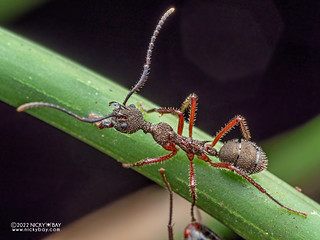
Ecuador: Dolichoderus attelaboides (Fabricius, 1775)
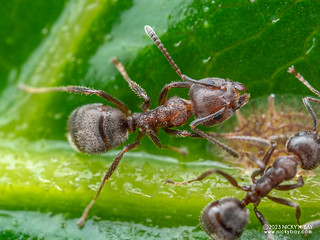
Singapore: Dolichoderus thoracicus (Smith, F., 1860)

Singapore: Dolichoderus thoracicus (Smith, F., 1860)

Belize: Dolichoderus bispinosus (Olivier, 1792)
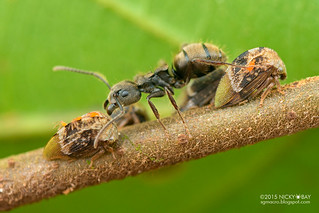
Belize: Dolichoderus bispinosus (Olivier, 1792)
Tribe: Tapinomini Emery, 1913
Genus: Technomyrmex Mayr, 1872

West Malaysia: Technomyrmex modiglianii Emery, 1900

West Malaysia: Technomyrmex modiglianii Emery, 1900
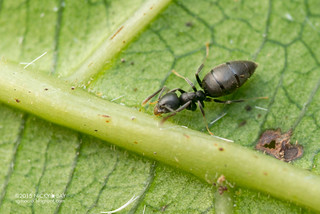
Singapore: cf. Technomyrmex sp.
Tribe: Unknown
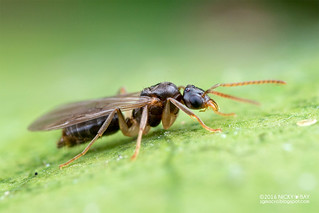
Singapore: Dolichoderinae ♂
Subfamily: Dorylinae Leach, 1815
Genus: Labidus Jurine, 1807

Peru: cf. Labidus praedator (Smith, F., 1858)
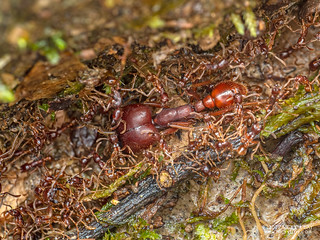
Ecuador: Labidus spininodis (Emery, 1890)
Subfamily: Ectatomminae Emery, 1895
Tribe: Ectatommini Emery, 1895
Genus: Ectatomma Smith, F., 1858
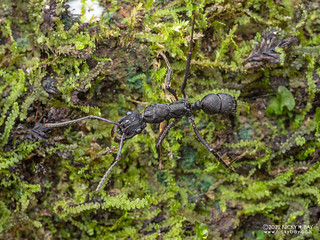
Ecuador: Ectatomma lugens Emery, 1894

Ecuador: Ectatomma tuberculatum (Olivier, 1792)
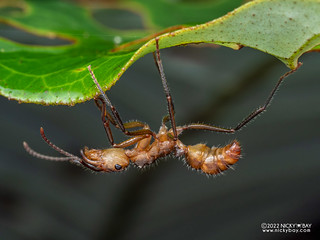
Ecuador: Ectatomma sp.
Genus: Gnamptogenys Roger, 1863

Ecuador: Gnamptogenys tortuolosa (Smith, F., 1858)
Genus: Stictoponera Mayr, 1887
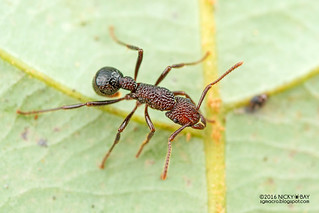
East Malaysia: Stictoponera cf. menadensis (Mayr, 1887)

East Malaysia: Stictoponera cf. menadensis (Mayr, 1887)

West Malaysia: Stictoponera menadensis (Mayr, 1887)
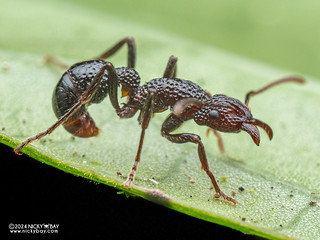
West Malaysia: Stictoponera menadensis (Mayr, 1887)

West Malaysia: Stictoponera cf. menadensis (Mayr, 1887)
Subfamily: Formicinae Latreille, 1809
Tribe: Camponotini Forel, 1878
Genus: Calomyrmex Emery, 1895

East Malaysia: Calomyrmex sp.

East Malaysia: Calomyrmex sp.
Genus: Camponotus Mayr, 1861

Singapore: Camponotus sp.

West Malaysia: Camponotus sp.

Singapore: Camponotus sp.

Singapore: Camponotus sp.
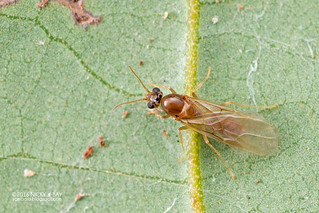
Singapore: Camponotus sp.
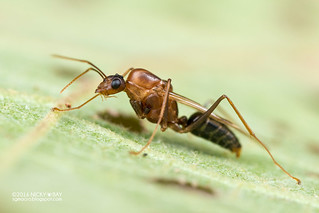
Singapore: Camponotus sp.

Singapore: Camponotus sp.
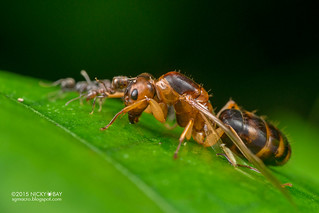
Singapore: Camponotus sp.

Singapore: cf. Camponotus sp.

Singapore: cf. Camponotus sp.

Singapore: Camponotus sp.

Singapore: Camponotus sp.

Ecuador: Camponotus nitidior (Santschi, 1921)
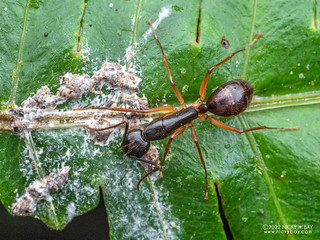
Ecuador: Camponotus sp.
Genus: Colobopsis Mayr, 1861

East Malaysia: Colobopsis saundersi (Emery, 1889) complex

East Malaysia: Colobopsis saundersi (Emery, 1889) complex

West Malaysia: cf. Colobopsis sp. DSC_3755

West Malaysia: cf. Colobopsis sp. P8287929
Genus: Dinomyrmex Ashmead, 1905
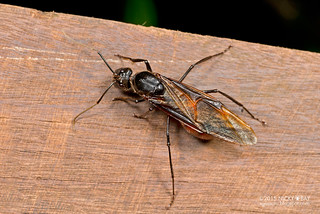
Singapore: Dinomyrmex gigas (Latreille, 1802)

Singapore: Dinomyrmex gigas (Latreille, 1802)

Singapore: Dinomyrmex gigas (Latreille, 1802)

Singapore: Dinomyrmex gigas (Latreille, 1802)

Singapore: Dinomyrmex gigas (Latreille, 1802)
Genus: Echinopla Smith, F., 1857

East Malaysia: Echinopla circulus Zettel & Laciny, 2015

East Malaysia: Echinopla circulus Zettel & Laciny, 2015

West Malaysia: Echinopla densistriata Stitz, 1938

West Malaysia: Echinopla densistriata Stitz, 1938
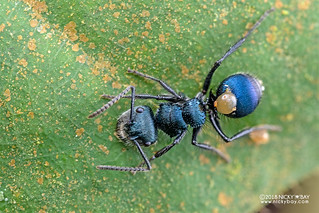
West Malaysia: Echinopla densistriata Stitz, 1938
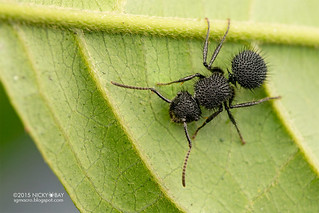
East Malaysia: Echinopla melanarctos Smith, F., 1857

East Malaysia: Echinopla melanarctos Smith, F., 1857

East Malaysia: Echinopla melanarctos Smith, F., 1857

Singapore: Echinopla striata Smith, F., 1857

Singapore: Echinopla striata Smith, F., 1857

West Malaysia: cf. Echinopla striata Smith, F., 1857
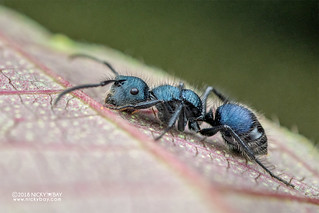
West Malaysia: cf. Echinopla striata Smith, F., 1857

West Malaysia: Echinopla sp.

West Malaysia: Echinopla sp.
Genus: Polyrhachis Smith, F., 1857

Singapore: Polyrhachis cf. armata (Le Guillou, 1842)

East Malaysia: Polyrhachis armata (Le Guillou, 1842)

Singapore: Polyrhachis armata (Le Guillou, 1842) complex

Cambodia: Polyrhachis bihamata (Drury, 1773)

Thailand: Polyrhachis bihamata (Drury, 1773)
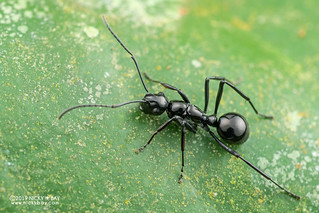
West Malaysia: cf. Polyrhachis boltoni Dorow & Kohout, 1995

East Malaysia: Polyrhachis bellicosa Smith, F., 1859 or
Polyrhachis olybria Forel, 1912

West Malaysia: Polyrhachis nigropilosa Mayr, 1872

West Malaysia: Polyrhachis rufipes Smith, F., 1858
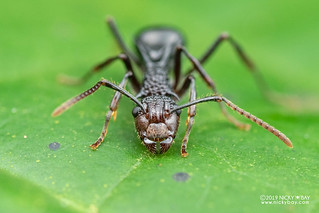
West Malaysia: Polyrhachis rufipes Smith, F., 1858

West Malaysia: Polyrhachis cf. thrinax Roger, 1863
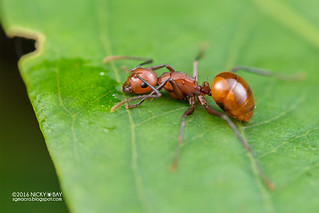
West Malaysia: Polyrhachis cf. thrinax Roger, 1863

West Malaysia: Polyrhachis mucronata Smith, F., 1859 complex

East Malaysia: Polyrhachis ypsilon Emery, 1887

East Malaysia: Polyrhachis ypsilon Emery, 1887

Thailand: Polyrhachis sp.

Singapore: Polyrhachis sp.

Singapore: Polyrhachis sp.

West Malaysia: Polyrhachis sp.

East Malaysia: Polyrhachis sp.

East Malaysia: Polyrhachis sp.

East Malaysia: Polyrhachis furcata Smith, F., 1858
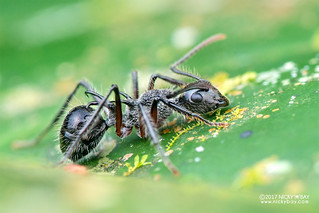
East Malaysia: Polyrhachis furcata Smith, F., 1858
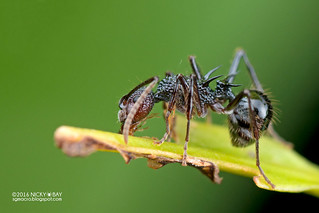
East Malaysia: Polyrhachis sp.

Singapore: Polyrhachis sp.
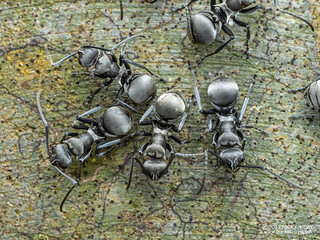
Singapore: Polyrhachis saevissima Smith, F., 1860
Tribe: Gigantiopini Ashmead, 1905
Genus: Gigantiops Roger, 1863

Ecuador: Gigantiops destructor (Fabricius, 1804)
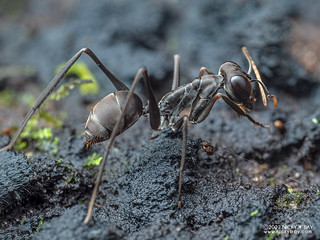
Ecuador: Gigantiops destructor (Fabricius, 1804)
Tribe: Lasiini Ashmead, 1905
Genus: Paraparatrechina Donisthorpe, 1947

Singapore: Paraparatrechina malaccana (Viehmeyer, 1916)
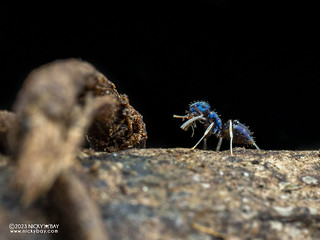
Singapore: Paraparatrechina malaccana (Viehmeyer, 1916)
Tribe: Myrmoteratini Emery, 1895
Genus: Myrmoteras Forel, 1893
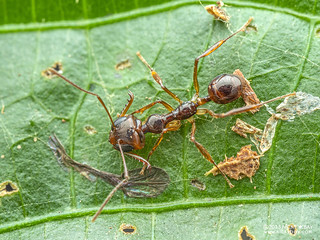
Thailand: Myrmoteras cf. opalinum Bui, Eguchi & Yamane, 2013
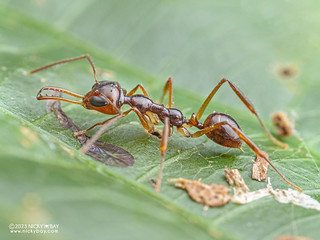
Thailand: Myrmoteras cf. opalinum Bui, Eguchi & Yamane, 2013
Tribe: Oecophyllini Emery, 1895
Genus: Oecophylla Smith, F., 1860

Singapore: Oecophylla smaragdina (Fabricius, 1775)

Singapore: Oecophylla smaragdina (Fabricius, 1775)

Singapore: Oecophylla smaragdina (Fabricius, 1775)
Tribe: Plagiolepidini Fore., 1886
Genus: Anoplolepis Santschi, 1914

Singapore: Anoplolepis gracilipes (Smith, F., 1857)

Singapore: Anoplolepis gracilipes (Smith, F., 1857)
Subfamily: Myrmicinae Lepeletier de Saint-Fargeau, 1835
Tribe: Attini Smith, 1858
Genus: Acromyrmex Mayr, 1865

Belize: Acromyrmex sp.

Belize: Acromyrmex sp.

Ecuador: Acromyrmex sp.

Ecuador: Acromyrmex sp.
Genus: Aphaenogaster Mayr, 1853

Singapore: cf. Aphaenogaster feae Emery, 1889
Genus: Apterostigma Mayr, 1865
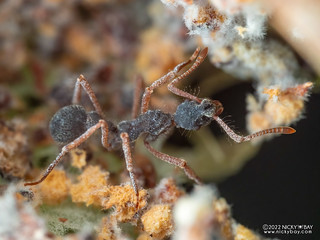
Ecuador: Apterostigma sp.

Ecuador: Apterostigma sp.
Genus: Atta Fabricius, 1804
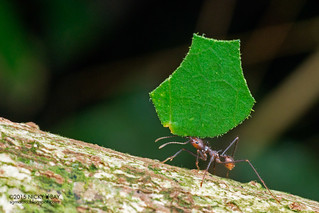
Belize: Atta sp.

Belize: Atta sp.
Genus: Cephalotes Latreille, 1802
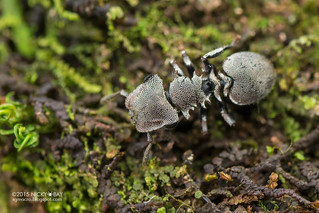
Belize: Cephalotes cristatus (Emery, 1890)

Belize: Cephalotes cristatus (Emery, 1890)

Ecuador: Cephalotes atratus (Linnaeus, 1758)
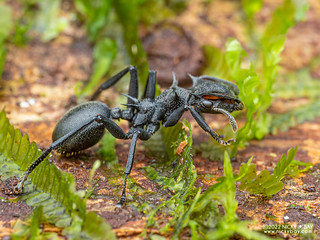
Ecuador: Cephalotes atratus (Linnaeus, 1758)
Genus: Daceton Perty, 1833
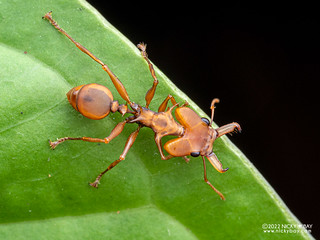
Ecuador: Daceton armigerum (Latreille, 1802)
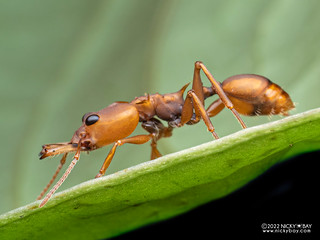
Ecuador: Daceton armigerum (Latreille, 1802)
Genus: Pheidole Westwood, 1839

Ecuador: Pheidole sp.

Ecuador: Pheidole sp.
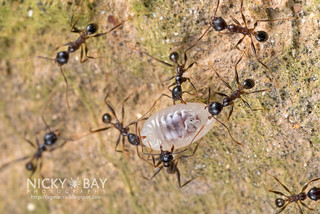
Singapore: cf. Pheidole sp. 0770
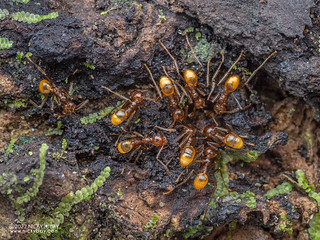
Ecuador: Pheidole sp.
Genus: Strumigenys Smith, F., 1860

Singapore: Strumigenys cf. godeffroyi Mayr, 1866

Singapore: Strumigenys cf. godeffroyi Mayr, 1866
Tribe: Crematogastrini Forel, 1893
Genus: Calyptomyrmex Emery, 1887

Singapore: Calyptomyrmex beccarii Emery, 1887

Singapore: Calyptomyrmex beccarii Emery, 1887
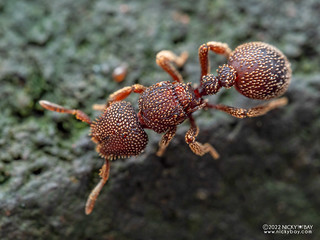
Singapore: Calyptomyrmex sp.

Singapore: Calyptomyrmex sp.
Genus: Cataulacus Smith, F., 1853
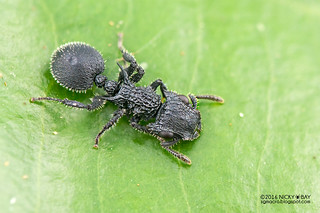
East Malaysia: Cataulacus horridus Smith, F., 1857

Singapore: Cataulacus cf. granulatus (Latreille, 1802)

West Malaysia: Cataulacus cf. latissimus Emery, 1893
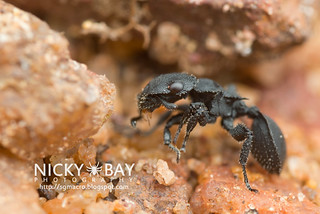
West Malaysia: Cataulacus cf. latissimus Emery, 1893

Singapore: Cataulacus praetextus Smith, F., 1867
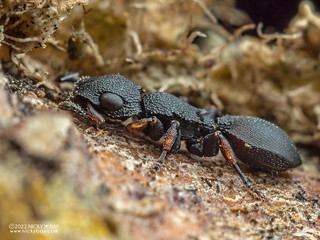
Singapore: Cataulacus praetextus Smith, F., 1867
Genus: Carebara Westwood, 1840

Singapore: Carebara sp.

Singapore: Carebara sp.
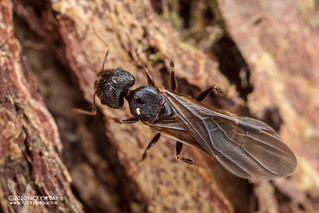
Singapore: cf. Carebara sp.

Singapore: cf. Carebara sp.
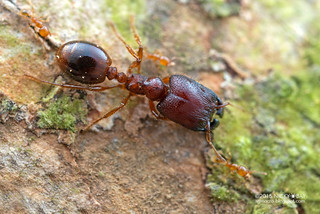
Singapore: Carebara sp.
Genus: Crematogaster Lund, 1831

East Malaysia: Crematogaster sp.

East Malaysia: Crematogaster sp.

West Malaysia: Crematogaster inflata Smith, F. 1857
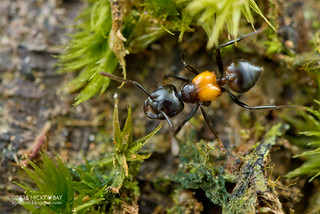
East Malaysia: Crematogaster inflata Smith, F. 1857

Singapore: Crematogaster sp.

West Malaysia: Crematogaster sp.

West Malaysia: Crematogaster cf. sewardi Forel, 1901
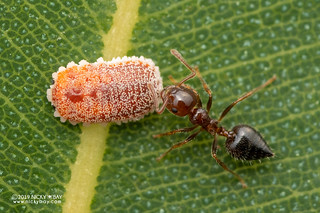
Western Australia: Crematogaster sp.
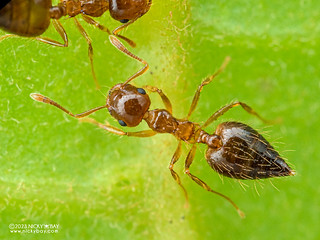
Singapore: Orthocrema sp.
Genus: Meranoplus Smith, F., 1853
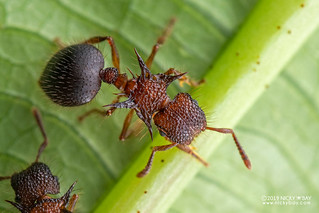
West Malaysia: Meranoplus mucronatus Smith, F., 1857

West Malaysia: Meranoplus mucronatus Smith, F., 1857

Singapore: Meranoplus cf. bicolor (Guérin-Méneville, 1844)

Singapore: Meranoplus cf. bicolor (Guérin-Méneville, 1844)
Genus: Pristomyrmex Mayr, 1866

Singapore: Pristomyrmex sp.

West Malaysia: Pristomyrmex sp.
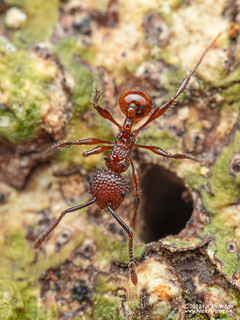
Singapore: Pristomyrmex bicolor Emery, 1900
Genus: Tetramorium Mayr, 1855
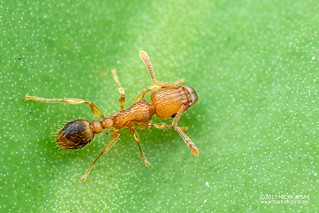
Singapore: Tetramorium bicarinatum (Nylander, 1846)
Singapore: Tetramorium bicarinatum (Nylander, 1846) complex

Singapore: Tetramorium lanuginosum Mayr, 1870

West Malaysia: Tetramorium sp.
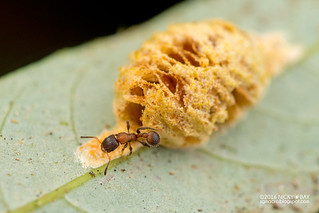
East Malaysia: Tetramorium sp.
Tribe: Solenopsidini Forel, 1893
Genus: Megalomyrmex Forel, 1885

Ecuador: Megalomyrmex sp.
Genus: Myrmicaria Saunders, W.W., 1842
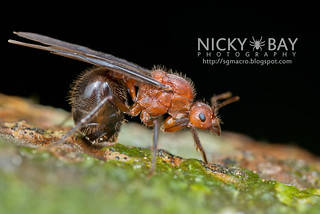
Singapore: Myrmicaria sp.
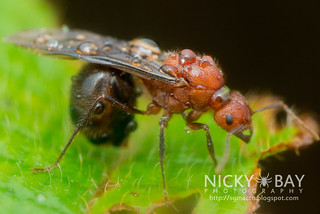
Singapore: cf. Myrmicaria sp.
Tribe: Unknown

Singapore: Myrmicinae ♂
Subfamily: Paraponerinae Emery, 1901
Genus: Paraponera Smith, F., 1858

Ecuador: Paraponera clavata (Fabricius, 1775)
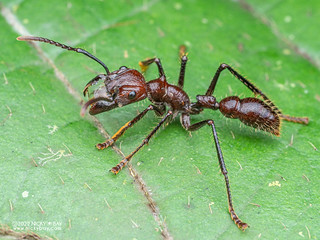
Ecuador: Paraponera clavata (Fabricius, 1775)
Subfamily: Ponerinae Lepeletier de Saint-Fargeau, 1835
Tribe: Platythyreini Emery, 1901
Genus: Platythyrea Roger, 1863

Singapore: cf. Platythyrea parallela (Smith, F., 1859)
Tribe: Ponerini Lepeletier de Saint-Fargeau, 1835
Genus: Anochetus Mayr, 1861

East Malaysia: Anochetus rugosus (Smith, 1857)

Singapore: Anochetus muzziolii Menozzi, 1932
Genus: Diacamma Mayr, 1862

Singapore: Diacamma sp.

Singapore: Diacamma sp.
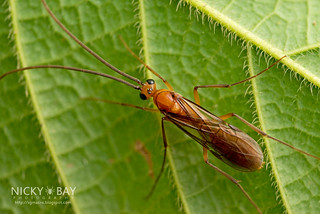
Singapore: Diacamma sp. ♂

Singapore: Diacamma sp. ♂

Singapore: Diacamma sp.

Singapore: Diacamma sp.
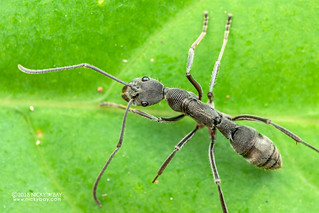
Singapore: Diacamma sp.

Singapore: Diacamma sp.

Singapore: Diacamma sp.
Genus: Ectomomyrmex Mayr, 1867

West Malaysia: Ectomomyrmex leeuwenhoeki (Forel, 1886)
Genus: Myopias Roger, 1861

Singapore: Myopias sp.

Singapore: Myopias sp.
Genus: Neoponera Emery, 1901

Ecuador: Neoponera foetida (Linnaeus, 1758)
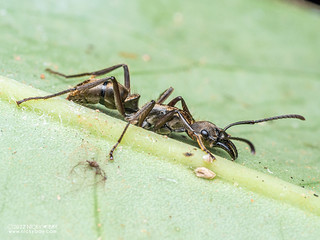
Ecuador: Neoponera foetida (Linnaeus, 1758)

Ecuador: Neoponera foetida (Linnaeus, 1758)
Genus: Odontomachus Latreille, 1804
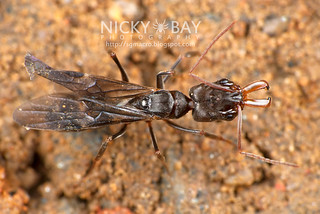
Singapore: Odontomachus sp.

Singapore: Odontomachus sp.
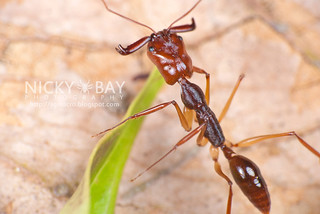
Singapore: Odontomachus sp.

Singapore: Odontomachus sp.
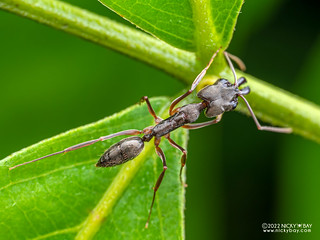
Ecuador: Odontomachus sp.

Ecuador: Odontomachus hastatus (Fabricius, 1804)
Genus: Odontoponera Mayr, 1862

Singapore: Odontoponera transversa (Smith, F., 1857)

Singapore: Odontoponera denticulata (Smith, F., 1858) ♂
Genus: Paltothyreus Mayr, 1862
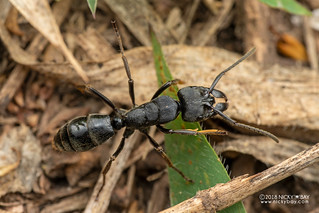
Mozambique: Paltothyreus cf. tarsatus (Fabricius, 1798)
Genus: Pseudoneoponera Donisthorpe, 1943

Singapore: Pseudoneoponera tridentata (Smith, 1858)
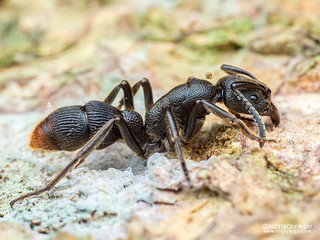
Singapore: Pseudoneoponera tridentata (Smith, 1858)
Genus: Unknown

Singapore: Ponerini

Singapore: Ponerini
Subfamily: Proceratiinae Emery, 1895
Tribe: Proceratiini Emery, 1895
Genus: Discothyrea Roger, 1863

Singapore: Discothyrea sp. P4096390
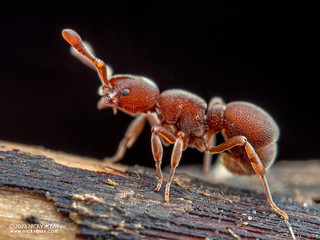
Singapore: Discothyrea sp. P4096390
Subfamily: Pseudomyrmecinae Smith, M.R., 1952
Genus: Pseudomyrmex Lund, 1831

Ecuador: Pseudomyrmex sp.
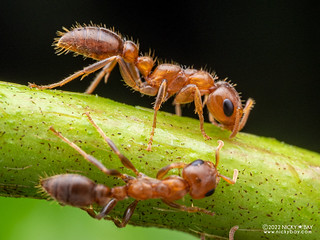
Ecuador: Pseudomyrmex sp.
Genus: Tetraponera Smith, F., 1852

Singapore: Tetraponera allaborans (Walker, 1859)
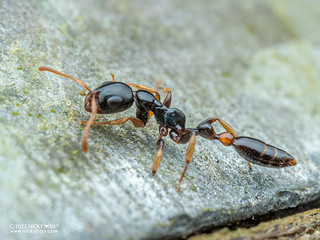
Singapore: Tetraponera allaborans (Walker, 1859)
Trophobiosis
Trophobiosis is common with ants where they exhibit a symbiotic relationship with other invertebrates such as sugar-excreting insects. The insects supply food in the form of their sugary excrement, while the ants offer protection from predators.

Singapore: Meranoplus sp. with Membracidae nymph

Peru: Camponotus sp. with Hypaepa costata

West Malaysia: Anoplolepis gracilipes with planthopper

East Malaysia: cf. Camponotus sp. with Cicadellidae

Belize: Dolichoderus cf. bispinosus (Olivier, 1792) with Adippe inaequalis

East Malaysia: Polyrhachis furcata Smith, F., 1858 with Busoniomimus sp.
Cordyceps Fungus
Ophiocordyceps is an insect-pathogenic fungus, also known as cordyceps fungus, that infects ants and controls their brains. Infected ants would climb to the tallest point, often the tip of tall grass or leaves, and die there. This aids the fungus in dispersal and self-propagation when the fungus grows its fruiting body out to disperse spores.
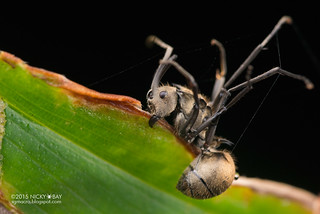
Singapore: Polyrhachis sp.

East Malaysia: Formicidae
Group Predation
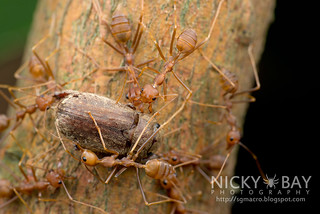
Singapore: Oecophylla smaragdina (Fabricius, 1775)

Singapore: Oecophylla smaragdina (Fabricius, 1775)
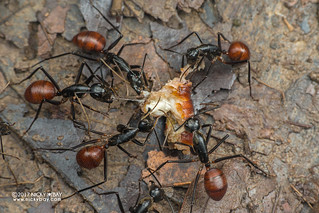
Singapore: Dinomyrmex gigas (Latreille, 1802)
Ant Predators
Many invertebrates are specialist ant predators. Here are some examples.

Singapore: Zodariidae

Singapore: cf. Inara flavopicta
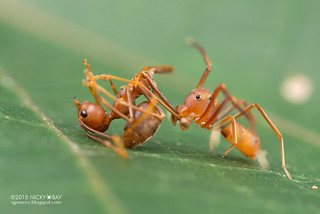
Singapore: Amyciaea sp.

Singapore: Alcimochthes sp.

Singapore: Episinus sp.
Ant Mimicry
Several invertebrates mimic ants. Batesian mimicry is the form where mimicking an ant reduces the risk of predation, as ants are typically unpalatable and aggressive to potential predators.
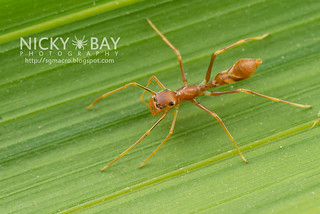
Singapore: Myrmarachne mimicking Oecophylla smaragdina

Singapore: Myrmarachne mimicking Polyrhachis

Singapore: Alydidae
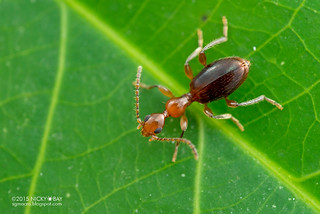
Singapore: Anthicidae

Singapore: Homodes sp.

Mozambique: Eurycorypha sp.
TAGS

